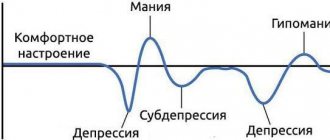Basic needs
Nature has carefully selected the basic needs for humans. There are only three of them:
- breath;
- nutrition;
- sex.
Why nature did this is difficult to say. Apparently she had some ideas. But man is the only animal that can voluntarily breathe, eat and have sex. And therefore, hold your breath, fast and abstain from sex.
Arbitrary control of these needs gives rise to a variety of options for satisfying them.
But just in case, the limiters of this behavior are embedded in the limbic system. The easiest way to observe the effect of limiters is through the feeling of hunger. When nutrients in the blood decrease, the lateral nuclei of the hypothalamus, which are often called the “hunger center,” begin to become excited. This excitation is transmitted to the cerebral cortex. If the arousal of the cortex is high at the moment, then hunger is not realized. But gradually the limbic system shifts attention to the hunger center to wider and wider layers of the cortex, until all a person’s attention is focused on the feeling of hunger.
Under normal conditions, basic needs are easily satisfied and therefore have virtually no effect on behavior.
Sometimes these needs are called survival needs. Attempts to explain all human behavior only by these needs are made constantly. The most famous example is Freud's theory of reducing all human impulses to sexual desire.
But the manifestations of human activity are so diverse that it is impossible to reduce them to one or two biological factors. Such primitivization of man is devoid of practical meaning.
It is curious that during dreams all basic brain functions reach the same intensity as during wakefulness. Instead of deep and sleepy breathing, breathing again becomes rapid and uneven. Gastric juice is released. Both men and women experience genital erections.
It's no wonder that many people consider dreams to be a second reality. Sometimes in the second reality a person feels even better than in the first. Genital erections were recorded even in ninety-year-olds.
Basic needs affect motivation only if they are dissatisfied, then their strength increases enormously. But once they are satisfied, their motivating power disappears.
Real and imaginary needs.
True needs, unlike imaginary ones, are not imposed from outside. Everyone comes to their true needs independently. Imaginary needs are formed under social pressure and caused by the influence of the external environment. Therefore, imaginary needs change over the years, just like society; a person will exist with genuine needs all his life. And basically it is not the need that changes, but the interests of the person through which he realizes this need.
Purchases that a client makes based on imaginary needs are usually impulsive in nature. Most likely, if you don’t make a purchase right away, but wait a week or a month, the desire will disappear. It is much more difficult to get rid of genuine needs; it can take a very long time for a person to realize such a need.
Genuine needs can also be characterized by the word “need”, and imaginary needs by the word “want”. For example, I have three children and I understand that I need a big car so that everyone can fit. But I want a sports car because it's cool.
Social needs
Social needs are still based on biological reasons. Man is a herd animal. Therefore, he has well-developed feelings of empathy and compassion.
You can laugh heartily at a funny comedy even alone. But in a crowded hall, the general burst of laughter has a much stronger impact. Being on a sports team, a person merges with it and feels the combined strength as his own. The general rejoicing over the joyful event in the life of the country forces people to take to the streets to feel a sense of belonging.
Experiments on voluntary isolation have shown how much a person needs other people. The subjects lived in completely comfortable conditions, but with one limitation. They could not communicate with other people. After a few months, they began to experience serious emotional difficulties.
Therefore, communication is necessary for a person in the same way as food, but with an important difference: communication is not just any communication, but within the framework of cultural traditions. If the people around you do not fit into the framework of a person’s social expectations, then a need arises to avoid communication. Isolate yourself from society. But immediately there is a desire to find a better society, to find those who understand you, because social needs require their satisfaction.
There are only two social needs:
- need for social status;
- need for emotional intimacy.
Social status is the place a person occupies in the social structure of society. Status is influenced both by factors independent of the individual - gender, age, nationality - and by achieved factors: education, professionalism, spiritual qualities. Status is a fairly dynamic value, which largely depends on the state of society as a whole. At different times, military personnel, politicians, scientists, and businessmen may receive higher status. All this forces a person to change his behavior, position, profession. A person wants to occupy a certain place in the social hierarchy. And the higher this place is, the better.
In each social group, a person should feel useful to the entire team and experience a sense of belonging to the common cause. Otherwise, he feels like an outcast and, if possible, leaves this group.
A person belongs to many groups. In each he has his own status. The number of these groups changes all the time, but there is the most important group where a person makes maximum efforts to move up - the professional one.
The main thing in social status is professional worth. A person wants to look like a master of his craft in the eyes of other people. And not just a master, but a master who has no equal. This need causes a desire to master the most subtle techniques of professional activity.
A person needs to be called not just a general, but a great commander, not a politician, but a leader of the country, not an artist, but a brilliant painter, not a writer, but a spiritual teacher.
From this need comes a strong motivation to be better than others: to win competitions, receive certificates, set records, and be in the spotlight. But often the motivation becomes false. A person replaces one thing with another. Instead of becoming professionally superior to others, he tries by any means to gain distinctions: prestigious things, nice-sounding positions, interest from the press. In this case, the “naked king” effect is obtained. Inflated fame quickly passes, but you can’t fool yourself. Therefore, this path leads to a dead end. The main need is not satisfied, and the energy has already been spent.
Then the person feels worthless and a failure. As a rule, such people give up in everyday life. They stop taking care of themselves, live as they please and often become drunkards.
Another mistake is that a person begins to confuse social status and self-esteem. In this case, he begins to saw the branch on which he is sitting. He mentally says to himself: “I will respect myself if I am considered a respected person.” This leads to the fact that a person becomes a slave of public opinion. He constantly looks around and listens to what others are saying about him. And then he tries to guess what else they might say or even think about him. All this causes fear of any public assessment. A person is afraid to speak, to appear inferior, afraid of a call to the boss, an exam. But such behavior quickly leads to a decline in social status. And then self-esteem decreases. And the person is more and more afraid of people and respects himself less and less.
To get out of the vicious circle, you should learn to distinguish self-esteem from external assessment. It’s easy if you focus your attention on this and tell yourself: “No matter what mistake I make, I am still a worthy member of society.”
The need for social status is an impersonal need. The person himself is not involved here - only his name is involved, and this name should be known to millions.
But the need for emotional intimacy is exactly the opposite - a person wants to be appreciated regardless of his professional merits. To be appreciated. This is where the need for love, friendship, family, children comes from.
Satisfying these needs requires a person to be able to establish and maintain emotional relationships with people. If he does not know how to do this, then very soon he feels his loneliness. Very often, people who have climbed the career ladder notice that there are only useful people around, including their own family. And there is no one to share your thoughts, doubts, and emotional experiences with. In this case, even high social status ceases to bring joy. What kind of joy is it if you can’t share it with anyone?
Satisfying social needs is very complex in its structure. Achieving a high social status and successfully building a personal life require a lot of effort. Problems arise for a person if he believes that someone should provide all this for him. In this case, a complex of “unrecognized genius” arises. A person thinks that he is being undeservedly ignored and that intrigues are being plotted against him. He sees those around him as insignificant envious people and intriguers. He gets confused in relationships with other people. He wants to be respected, but he himself does not respect anyone. These conflicting desires give rise to numerous types of mental disorders.
There is only one way out in such a situation. A person must admit that he is neither higher nor lower than others. And you can achieve respect and love in only one way: to make your life useful and joyful for other people.
presentation “psychological needs” presentation for a lesson on the topic
Slide 1
The concept of needs Need is a state of need for certain living conditions, activities, material objects, people or certain social factors, without which a person experiences a state of discomfort.
Slide 2
Features of needs: 1. Needs are always associated with a person’s feeling of dissatisfaction, which is caused by a shortage of what is required. 2. Needs determine the selectivity of perception of the world, fixing a person’s attention on those objects that can satisfy this need (“A hungry godfather has only bread on his mind,” “Whoever hurts, talks about it.”) 3. The presence of a need is accompanied by emotions: first, as the need intensifies, negative, and then, if it is satisfied, positive. 4. The number of needs increases in the process of phylogenesis (the process of changes in the psyche as a product of evolution) and ontogenesis (the development of the psyche from birth to the end of life). Thus, the number of needs increases in the evolutionary series: plants - primitive animals - highly developed animals - humans, as well as in the ontogenetic series: newborn - infant - preschooler - schoolchild - adult. 5 . Human needs form a hierarchical system, where each need has its own level of significance. As they are satisfied, they give way to other needs.
Slide 3
Our actions are the realization of our personal goals, desires and needs. Moreover, need is one of the important components of our behavior, mood and life in general. Need is an internal state of psychological or functional feeling of lack of something. Needs are internal drivers of activity; they manifest themselves in different ways depending on the situation. There is no exact classification of needs in psychology, but there are several different theories. One of the most famous is the so-called Maslow pyramid. At the heart of Maslow's pyramid are the physiological needs associated with providing for the body. Next come everyday needs that determine human development in society. It is the need for security, belonging, love, respect and honor. The top of the pyramid is the so-called meta-needs. They are associated with self-knowledge, self-realization and self-improvement. Now let's talk more about psychological needs.
Slide 4
Psychological needs
Slide 5
A type of vital needs are psychological needs, without the satisfaction of which young children do not receive full development. They do not die, but seem to freeze, stop developing and are often susceptible to diseases that bypass children in a more prosperous environment. If basic physiological needs are not met, the body (physical health) suffers. If basic psychological needs are not met, the soul, the body of the soul (mental health) suffers.
Slide 6
Psychological needs are needs that cannot be reduced to physical ones, but do not reach the level of spiritual ones. Psychological needs usually include the need for communication, acceptance, stability, novelty, significance, growth, affiliation (the need for emotional contacts), the desire to help others, and many others.
Slide 7
The need for love, recognition, acceptance, approval We all come from childhood. We all, to varying degrees, experience the need for recognition, love, acceptance of who I am. Satisfying this need supports us, helps us feel strength, self-confidence, independence, and integrity. Helps build relationships with people. Helps to be sincere, responsive, caring, understanding, forgiving and accepting. Capable of loving, feeling themselves and others, taking into account their own and other people's needs. We all come from childhood, and everyone’s childhood is different. Everyone has their own story; someone found their childhood in war, famine, poverty. Some had no parents, or had one parent, and some grew up and were brought up in a complete family. There are those who grew up in material prosperity, those in poverty, or in the middle class. These, and many other factors, affect the physical and psychological health of the child. But the most important need for a child has always been parental love, acceptance, recognition and approval. Just as satisfying physiological needs is important for a child, satisfying emotional hunger is no less important. A child under 5 years old perceives information mainly non-verbally, peering into the eyes of his parents as indicators of what kind of person I (the child) is. The child passes any action of the parents through the prism: I am good, or I am bad! Nothing goes unnoticed. This is how the child’s personality and his future destiny are formed.
Slide 8
Through the prism of relationships towards oneself, one’s attitude towards people around us and the whole world is formed. Anyone who has not fully satisfied his need for love, recognition and approval is himself not adequately able to love, approve, support and accept another person. Almost all a person’s feelings are “umbrella”, i.e., what I feel for myself is what I feel for others, and vice versa. How a child’s self-image develops can be seen from an example: the father left the family, the child does not perceive this as the fact that the father has another woman, and he already has his own life, but perceives it as I (the child) am bad, and It was my father who left me. Or the mother went to the store and left the little child alone at home. The child gets hysterical because he perceives his mother’s action as rejection (I’m bad). The fear of rejection and the need for recognition encourage the child to be more resourceful and dexterous in order to receive attention, love, and approval. As a way of “survival,” the child plays typical games and roles, puts on “masks,” all in order to receive attention and recognition from his parents.
Slide 9
Need for acceptance If we have people who are significant to us, we don’t want to be strangers to them. We want acceptance. If a person is a stranger to everyone, this makes an ordinary person feel bad, and his desire to be someone’s friend is called the need for acceptance. However, the desire to belong (the need for acceptance) often pushes people to uncritically adopt unnecessary, unpromising, and even downright antisocial norms, and to erroneous behavior.
Slide 10
Stability is a basic psychological need of a person. It can be summarized in a simple sentence: the belief that things will not get worse. Stability is a psychological concept based on our thoughts, and not on objective reality. Stability is the mirror image of physical comfort in our minds, the belief that our main need, physical comfort, will continue.
Slide 11
Novelty is a constant human need, which, if not satisfied, causes us serious discomfort in the form of boredom. We love to study, watch different movies, travel to new places, experience new sensations and even get nervous when the dishes on our plate are repeated throughout the day! Novelty is one of the strongest human needs, which increases in importance immediately after stability is achieved and begins to conflict with it. In search of stability, people get married and find permanence. \ But after it comes the need for novelty and their future together is no longer so predictable. We often don't know what we want, not because of stupidity, but because our needs contradict each other. And at different periods of time, our desires change, balancing between stability and novelty. This should be accepted as a normal phenomenon, and not ask yourself the question: “What’s wrong with me?” By the way, the older we get, the more we learn about this world, which means the less new things surround us, and over the years, boredom can become a serious problem. Adults, instead of self-knowledge that has increased with experience, due to boredom, begin to “search for themselves” more and more, while in fact they are not looking for themselves, but for novelty, which is rapidly disappearing from their lives with each new sensation they experience.
Slide 12
Significance The human need that is perhaps the most insatiable is our significance, importance. We are ready to forgive the person who accidentally gave us a bruise and at the same time apologized, but we can grab the throat of someone who thought bad things about us. Deep in our minds we think that the ratio of us to all humanity is not 1:5,000,000,000 (billions), but 1:1. Me and the world. At the same time, we must understand that our significance performs a most important function in human evolution. The psychological need to be significant sets a high standard for us and we strive to be better. We come up with an image for ourselves and bend over backwards to live up to it. We try to gain the respect of others and are willing to pay a high price for it. We are ready to work and study 12 hours a day, just to be better than others or to surpass ourselves yesterday. Since childhood, we dream of becoming fashion models, artists, because we think that what we will do will make us significant. We believe that our dream profession will make us important in the eyes of other people. Remember yourself as a child. Today's human evolution owes much to the human need for significance.
Slide 13
Growth If you combine the two human needs of significance and novelty, you get growth. Personal growth, bank account growth, improvements. This need is so strong in us that it exists separately from the rest. We want to develop, we think about how to change ourselves, to become better. There's never enough for us. We need to improve everything. Improving oneself is a separate need that exists in each of us.
Slide 14
Communication The human need for communication explains the huge number of languages that have formed on the planet. If you analyze your life, you will notice that the best feelings in your life are associated with other people. We cannot become happy alone. People are afraid of imprisonment not so much because it will restrict their freedom of movement, but because they will be torn out of their usual social circle. Communication is a human need that can either conflict with or help satisfy all other needs if it happens with the right people. That is why our happiest moments and greatest misfortunes are connected with other people - communication with them is intertwined with several basic human needs.
Slide 15
The need for communication in children Communication is also characterized by a special need that is not reducible to other life needs of the child. The latter is defined through the product of activity as the desire for evaluation and self-esteem, for knowledge and self-knowledge. There are several stages in the development of a child's need for communication with an adult: The need for the attention and goodwill of an adult. This is a sufficient condition for the well-being of a child in the first half of life. Need for adult cooperation or complicity. This content of the need for communication appears in the child after he has mastered voluntary grasping. The need for respect from an adult. It arises against the background of children’s cognitive activity aimed at establishing sensory, non-perceptible relationships in the physical world. Children strive for a kind of “theoretical” cooperation with adults, expressed in a joint discussion of phenomena and events in the objective world. Only an adult's understanding of the importance of these issues for the child ensures such cooperation. The need for mutual understanding and empathy of an adult. This need arises in connection with children’s interest in the world of human relationships and is conditioned by children’s mastery of the rules and norms of their relationships. The child strives to achieve commonality of views with the adult. This will allow the baby to use them as a guide in his actions.
Slide 16
The need for communication in adults Today, the following desires (needs) are considered to be manifestations of the need for communication in adults: The need for a positive assessment, approval The need for psychological security The need for attention The need for equality The need for a person to participate in solving all issues affecting him The need for information Need for recognition of competence Need for gratitude Need for laughter (need for emotions from neutral humor) Need for closure of communication
Slide 17
The desire to help others Another human need is the desire to help others. The desire to help others is least associated with the instinct of self-preservation and therefore works weaker than other psychological needs. In addition, we cannot give to another what we ourselves do not have. Only when basic needs are satisfied do we turn our attention to others and begin to help them. Yes, it’s true, we are unlikely to give our last piece of bread to someone, but we can share if we have a lot of bread. The desire to help people comes last on the list of human needs, but this does not mean that we have to live to old age to engage in philanthropism. Helping others develops many other qualities that are beneficial for success and manifests itself in our behavior to varying degrees from an early age.
Slide 18
Basic needs of a teenager: the need for attention and support without judgment and evaluation, that is, for the non-judgmental warmth, acceptance and wisdom of adults; need for interesting life events. Interest is the main engine of a person’s personal development; in adolescence it is maximally active and constantly requires satisfaction; need for pleasure - a teenager studies himself, his feelings and sensations, he strives for sensory enrichment, it is natural that pleasures are the most experienced desires; need for respect and recognition - when a person receives respect and recognition, he develops strong self-confidence as a valuable person, and this forms the basis for success in all areas of his life; the need for communication and acceptance by peers - a teenager strives to gain social experience and develops the most successful models of behavior that help him assert himself, feel confident, receive love, sympathy, recognition; it is important for a teenager to know that he is valuable to others, that his opinion matters; he is ready to do everything so that the real or imaginary group of people to which he would like to belong (the reference group) recognizes him as “one of their own,” even if this means stepping on the throat of his own “I”; .
Slide 19
the need for the ability to confidently defend one’s opinion (which is based on general self-confidence) - it is the inability to do this that leads to many problems in the life of a teenager that limit his self-regulation and development - shyness, dependence on a bad community, feelings of helplessness and worthlessness, refusal of future professional success, etc.; the need for creative self-expression and self-realization - creative self-realization is the strongest current in the development of a teenager; if he finds an opportunity to satisfy this need, he practically finds an opportunity to satisfy all the others; creatively self-actualizing, a teenager gains practical life experience - he is interested, he develops, he has respect for himself, receives the results of his creativity, he is accepted by others, and it is easy for him to live within the clear boundaries of his creativity; the need to set life goals - despite the teenager’s desire to “live now,” his clear definition of his future brings order to his life, relieves a large amount of anxiety and allows him to direct his personal resources in a certain direction.
Slide 21
Human psychological needs require more attention in the modern world, since physiological ones are already easily satisfied, thanks to the achievements of mankind and the increased standard of living.
Slide 22
Thank you for your attention!!!
Intellectual needs
Physiological and social needs are inherent in all animals. If a person satisfies only these needs, then he remains an animal.
He becomes human only at the moment of using his intellect. Otherwise, it is a dummy of a person.
Chasing the pleasures of the body and symbols of social status does not bring happiness. Only intelligence can give happiness.
A person has only one intellectual need - inspiration. Inspiration is a special state of the intellect. Inspired intelligence operates at the peak of its capabilities, with maximum efficiency.
Internally, this need is recognized as a desire for knowledge and success. The desire for knowledge is expressed first in curiosity, and as knowledge accumulates, in the desire to penetrate into the deepest secrets of the universe. Find out the most hidden details.
The desire for success is expressed in the desire to remake this world. Disassemble each phenomenon into screws, and then assemble it in the best configuration.
In a harmoniously developed person, knowledge and success go together, creating a feeling of a seething stream of life. When this flow covers a person completely, a state of inspiration occurs.
The scope of inspiration is very wide. They include science, art, politics, and sports. In all cases, a person strives to learn and achieve success. Inspiration can also be directed at oneself - then the need for self-knowledge and self-improvement is born.
How to write a term paper on speech therapy
07.09.2010 192798
These guidelines are compiled to help students gain an understanding of the content and structure of coursework in speech therapy.
Logopedia of pedagogical science that studies anomalies of speech development with normal hearing, explores the manifestations, nature and mechanisms of speech disorders, develops the scientific basis for overcoming and preventing them means of special training and education.
The subject of speech therapy as a science is speech disorders and the process of training and education of persons with speech disorders.
The object of study is a person suffering from a speech disorder.
The main task of speech therapy as a science is the study, prevention and elimination of various types of speech disorders.
Coursework in speech therapy is a student's scientific and experimental research. This type of educational activity, provided for by the educational and professional program and curriculum, contributes to the acquisition of skills in working with literature, analyzing and summarizing literary sources in order to determine the range of insufficiently studied problems, determining the content and methods of experimental research, processing skills and qualitative analysis of the results obtained. The need to complete coursework in speech therapy is due to the updating of knowledge concerning the content, organization, principles, methods and techniques of speech therapy work.
As a rule, during their studies, students must write two term papers - theoretical and practical.
The first course work should be devoted to the analysis and synthesis of general and specialized literature on the chosen topic. Based on this analysis, it is necessary to justify and develop a method of ascertaining (diagnostic) experiment.
In the second course work, it is necessary to provide an analysis of the results obtained during the ascertaining experiment, as well as determine the directions and content of speech therapy work, and select adequate methods and techniques of correction.
So, let’s present the general requirements for the content and design of coursework in speech therapy.
The initial and most important stage of working on a course project is the choice of a topic, which is either proposed by the supervisor or chosen by the student independently from a list of topics that are consistent with the areas of scientific research of the department.
Each topic can be modified, considered in different aspects, but taking into account a theoretical and practical approach. Having chosen a topic, the student needs to think through in detail its specific content, areas of work, practical material, etc., which should be reflected both in the formulation of the topic and in the further construction of the study. It should be recalled that the chosen topic may not only have a purely theoretical orientation, for example: “Dysarthria. Characteristics of the defect”, “Classification of dysgraphia”, but also take into account the practical significance of the problem under consideration, for example: “Speech therapy work on speech correction for dysarthria”. It should also be taken into account that when formulating a topic, excessive detail should be avoided, for example: “Formation of prosodic components of speech in preschoolers of the sixth year of life attending a preschool institution for children with severe speech impairments.”
The course work includes such mandatory parts as: introduction, three chapters, conclusion, bibliography and appendix.
The text of the term paper begins with the title page . An example of its design can be seen here.
Then the content of the work is given, in which the names of chapters, paragraphs, and sections are formulated in strict accordance with the content of the thesis. An example of its design can be seen here.
In the text, each subsequent chapter and paragraph begins on a new page. At the end of each chapter, the materials are summarized and conclusions are formulated.
The introduction reveals the relevance of the problem under consideration in general and the topic being studied in particular; the problem, subject, object, and purpose of the study are defined. In accordance with the goal and hypothesis, objectives and a set of research methods aimed at achieving the objectives must be defined.
The relevance of the topic lies in reflecting the current level of pedagogical science and practice, meeting the requirements of novelty and usefulness.
When defining the research problem, it is important to indicate what practical tasks it will help to implement in training and educating people with speech pathology.
The object of research is understood as certain aspects of pedagogical reality, perceived through a system of theoretical and practical knowledge. The ultimate goal of any research is to improve this object.
The subject of research is some part, property, element of an object, i.e. the subject of research always indicates a specific aspect of the object that is to be studied and about which the researcher wants to gain new knowledge. An object is a part of an object.
You can give an example of the formulation of the object, subject and problem of research:
– The object of the study is the speech activity of preschool children with phonetic-phonemic speech disorders.
– The subject of the study is the features of intonation speech of children with phonetic-phonemic speech disorders.
– The research problem is to determine effective directions for speech therapy work on the formation of intonation expressiveness of speech in the system of correctional intervention.
The purpose of the study contributes to the specification of the object being studied. The goal of any research is to solve a specific problem. The goal is specified in tasks taking into account the subject of research.
The research objectives are formulated in a certain sequence, which determines the logic of the research. The research objectives are set on the basis of a theoretical analysis of the problem and an assessment of the state of its solution in practice.
The first chapter is an analysis of literary sources, which examines the state of this problem in historical and modern aspects, and presents the most important theoretical principles that formed the basis of the study.
When writing the first chapter, you should pay attention to the fact that the text of the course work must be written in a scientific style. When presenting scientific material, it is necessary to comply with the following requirements:
– Specificity – a review of only those sources that are necessary to disclose only a given topic or solve only a given problem;
– Clarity – which is characterized by semantic coherence and integrity of individual parts of the text;
– Logicality – which provides for a certain structure of presentation of the material;
– Reasoning – evidence of thoughts (why this and not otherwise);
– Precision of wording, excluding ambiguous interpretation of the authors’ statements.
A literary review of the state of the problem being studied should not be reduced to a consistent presentation of literary sources. It should present a generalized description of the literature: highlight the main directions (currents, concepts, points of view), analyze in detail and evaluate the most fundamental works of representatives of these directions.
When writing a work, the student must correctly use literary materials, make references to the authors and sources from which the results of scientific research are borrowed. Failure to provide required references will reduce your coursework grade.
As a rule, in coursework on speech therapy, references to literary sources are formatted as follows: the number of the cited source in the general list of references is placed in square brackets. For example: General speech underdevelopment is a speech pathology in which there is a persistent lag in the formation of all components of the language system: phonetics, vocabulary and grammar [17].
When using quotations, in square brackets, in addition to indicating the source number, the page number from which this excerpt is taken is indicated, for example: Speech rhythm is based on a physiological and intellectual basis, since, firstly, it is directly related to the rhythm of breathing. Secondly, being an element that performs a communicative function, “correlates with meaning, i.e. controlled intellectually” [23, P.40].
However, course work should not be of a purely abstract nature, so you should not abuse the unreasonable abundance of citations. Quoting should be logically justified, convincing and used only when really necessary.
In the second chapter , devoted to experimental research, the organization should be described and the program of the ascertaining experiment should be presented. The survey methodology, as a rule, consists of a description of several series of tasks, with detailed instructions, visual and lexical material, the procedure for completing tasks by experiment participants, and scoring criteria. This chapter also provides a qualitative and quantitative analysis of the results obtained.
When analyzing the results of an experiment, it is necessary to use a scoring system. Examples of various criteria for quantitative and qualitative assessment are presented in the following works:
– Glukhov V.P. Formation of coherent speech in preschool children with general speech underdevelopment. - M.: Arkti, 2002. - 144 p.
– Fotekova T.A. Test methodology for diagnosing oral speech of primary schoolchildren. - M.: Arkti, 2000. - 56 p.
– Levchenko I.Yu. Pathopsychology: Theory and practice. - M.: Academy, 2000. - 232 p.
In order to visually present the results obtained during the experimental study, it is recommended to use tables, graphs, diagrams, etc. Histograms can be used in a variety of ways - columnar, cylindrical, planar, volumetric, etc. An example of the design of tables, figures, and histograms can be found here.
The third chapter provides a rationale for the proposed methods and techniques and reveals the content of the main stages of correctional work.
The conclusion contains a summary of the material presented and the main conclusions formulated by the author.
The bibliography must contain at least 25 sources. The list includes bibliographic information about the sources used in preparing the work. An example of its design can be seen here.
In the application you can present bulky tables or illustrations, examination protocols, observation records, products of activity (drawings, written works of children), notes from speech therapy classes, etc.
The volume of one course work must be at least 30 pages of typewritten text.
In general, coursework in speech therapy is the basis for a future thesis, in which the study of the begun problem can be continued, but from the standpoint of a different approach or a comparative analysis of the disorders being studied in different age categories of people with different types of speech disorders.
The content and format of theses in speech therapy can be found here.
Literature:
1. How to write a term paper on speech therapy: Methodological recommendations. Educational and methodological manual / Comp. Artemova E.E., Tishina L.A. / Ed. Orlova O.S. – M.: MGOPU, 2008. – 35 p.
2. Research work of students in the system of higher professional pedagogical education (specialty 031800 - Speech therapy). Methodological recommendations for completing the thesis / Compiled by. L.V. Lopatina, V.I. Lipakova, G.G. Golubeva. - St. Petersburg: Publishing house of the Russian State Pedagogical University named after. A. I. Herzen, 2002. - 140 p.






